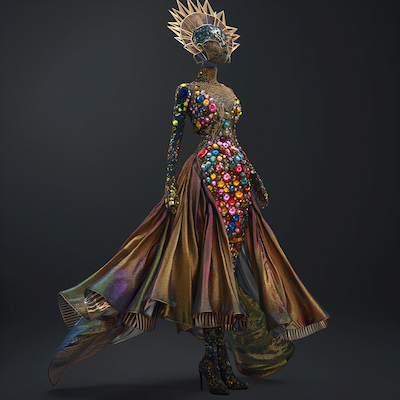
Costume design plays a crucial role in art and visual storytelling, serving as one of the most expressive elements in productions such as theater, film, and television. It not only complements the aesthetics of a work but also significantly contributes to shaping character identities and setting the tone of the story. Through careful choices of clothing, colors, textures, and styles, costume designers have the ability to convey information that goes far beyond what is spoken. Costumes become an extension of the narrative, helping to communicate emotions, relationships, and social contexts.
Furthermore, costumes reflect the time and setting in which the story takes place. They can evoke culture, social class, and even the psychology of the characters. For example, in a production that portrays a specific historical period, costumes help transport the audience to that era, creating a deeper connection with the narrative. Therefore, the importance of costume design goes beyond appearance—it is a powerful tool that shapes the audience’s perception and enriches the visual experience of a work.
How Costumes Work in Building Characters and Atmospheres
Costumes function as a visual language that helps tell a character’s story. From the first sketches to the final fabric choices, every decision is made with the intention of reflecting the character’s personality and journey. For example, a character portrayed as shy might wear more understated clothing in neutral tones, while an extroverted character could be dressed in vibrant colors and bold styles. This visual choice communicates to the audience who that character is and what role they play in the story.
In addition to defining personality, costumes also play a key role in creating atmospheres. In a suspense scene, for example, the use of dark colors and heavy fabrics can enhance tension, while in a romantic comedy, light colors and airy fabrics might evoke a sense of joy and ease. Thus, costumes not only characterize the characters but also shape the audience’s perception of the environment and emotional tone of the scene.
Another important aspect of costume design is its ability to evolve throughout the narrative. As characters face challenges and undergo experiences, their costumes can reflect these changes. A character who begins with a disheveled style may, after a personal transformation, adopt a more refined wardrobe. This visual evolution not only signals the character’s growth but also allows the audience to connect more deeply with their journey.
Finally, costumes are essential for the visual cohesion of a production. Harmony between costumes and other visual elements—such as sets, lighting, and props—is crucial for creating an immersive experience. A costume that stands out too much can disrupt the narrative illusion, while well-integrated design can fully immerse the audience in the story being told.

Advantages of Effective Costume Design in Visual Representation
Effective costume design brings a variety of advantages to visual storytelling in artistic productions. First, it helps establish an immediate connection between the audience and the characters. When costumes are well-crafted, they allow the viewer to quickly grasp the characters’ motivations and traits, facilitating identification and empathy. This is especially important in complex narratives, where emotional engagement is key to understanding the story.
In addition, a well-designed costume can reinforce the themes of the work. For instance, in a story that explores social issues, costumes can symbolize inequality and the struggles faced by the characters. Through material choices, styling, and color schemes, the designer can deliver powerful messages that complement the narrative and provoke reflection. This synergy between costume and theme enriches the viewer’s experience and makes the story more impactful.
Another significant advantage is the creation of memorability. Iconic characters are often remembered not only for their actions but also for their distinctive costumes. Think of characters like the Joker or Wonder Woman—their costumes are instantly recognizable and have become part of popular culture. A memorable costume can help solidify a character’s image in the audience’s mind, contributing to the lasting legacy of the work.
Lastly, effective costume design can enhance the credibility of the narrative. When costumes are authentic and appropriate to the historical or cultural setting of the story, they create a sense of realism that is essential for audience immersion. A costume that feels out of place or anachronistic can break the suspension of disbelief and disconnect viewers from the story. Therefore, attention to detail in costume design is crucial for ensuring a positive reception of the narrative.
How Costumes Influence Character and Atmosphere Construction
Costumes help define a character’s personality. Through choices in style, color, and texture, designers can instantly communicate who a character is and what their traits are. For example, extravagant clothing might suggest confidence and boldness, while more modest attire might indicate shyness or insecurity.
The choice of colors in costume design can create different atmospheres. Warm colors like red and yellow can evoke feelings of joy and excitement, while cool tones like blue and gray may suggest sadness or melancholy. This relationship between color and emotion is a powerful tool used by costume designers to guide the audience’s experience.
Costume design can tell the story without words. Costumes are often used to symbolize changes in the narrative or in the characters’ emotional states. For instance, a character going through a transformation might have their wardrobe evolve throughout the story, reflecting their personal growth or decline.
Costume details reflect the cultural context of the narrative. Elements such as accessories, patterns, and garment styles can be used to situate the story in a specific place or time. This not only enriches the narrative but also educates the audience about different cultures and historical settings.
Costume aesthetics can capture the audience’s attention. A visually striking costume can stand out and leave a lasting impression. This is especially important in productions where attention is highly contested, such as action films or large-scale theatrical performances.
Costumes can evolve with the character throughout the story. As characters change and grow, their costumes can reflect these transformations. This visual evolution not only signals character development but also allows the audience to emotionally connect with the journey being portrayed.
Costume design is therefore a multifaceted tool that plays a vital role in building characters and atmospheres. It not only defines the visual identity of characters but also influences the audience’s perception of the narrative. Considering all these factors, it becomes clear that costume design is an art form that goes far beyond appearance—it is an essential part of visual storytelling.

Did You Enjoy Learning About the Role of Costumes in Building Characters and Atmospheres?
The role of costumes in building characters and atmospheres is fascinating and full of nuance. By exploring how clothing can influence audience perception and enrich the narrative, we hope to have sparked your interest in this important art form. Costumes are far more than just clothing—they are a way of visually telling stories.
If you were intrigued by the impact that costume design can have on a production, we invite you to dive deeper into the topic. From the history of costume design to the techniques used by professionals in the field, there’s a world of knowledge waiting for you. Explore this art form and discover how it can transform the way we perceive and experience stories.
Frequently Asked Questions
What is the role of costume in building characters and atmospheres?
Costume helps tell the story. It shows who the character is and how they feel. It creates a connection with the audience.
How can costume influence audience perception?
You can sense emotions and intentions through clothing. A colorful costume may convey joy, while darker clothes may suggest sadness. Costume says a lot.
What should be considered when choosing a costume for a character?
It’s important to think about the time period, setting, and personality. Clothing should reflect the character’s choices. This helps you understand the story better.
Can costume change throughout the story?
Yes, it’s very common. Changes in costume show a character’s growth or new circumstances. This supports the development and atmosphere of the story.
How does culture influence costume in character development?
Culture brings unique elements. Styles, colors, and cuts may indicate background or tradition. This enriches the narrative and connects the viewer to the theme.

